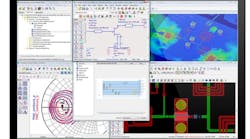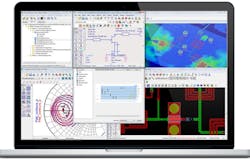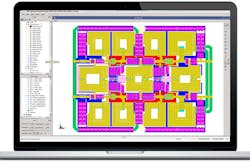Take a Path to Accelerated Design Workflows
One significant headline coming out of IMS 2019 was Keysight Technologies’ announcement of PathWave Design 2020, a collection of new releases of the company’s electronic-design-automation (EDA) software tools. Intended to accelerate design flows across industries, PathWave Design 2020 encompasses RF/microwave circuit design, system-level design, device modeling, high-speed digital design, and power electronics.
PathWave Design 2020 includes PathWave Advanced Design System (ADS) 2020, PathWave System Design (SystemVue) 2020, PathWave RF Synthesis (Genesys) 2020, PathWave RFIC Design (GoldenGate) 2020, and PathWave Device Modeling (IC-CAP) 2020 (Fig. 1).
1. PathWave Design 2020 includes PathWave Advanced Design System (ADS) 2020.
Before getting into the specifics of PathWave Design 2020, it’s important to have a good grasp of some of today’s requirements. According to Keysight, “Gone are the days of simple electronic circuit design. Every year, companies are pushing new limits: longer battery life, smaller components, and higher levels of integration. As a result, design and test engineering requirements are growing exponentially.”
The company also explains that “as the amount of data collected grows, companies know that they need a new way to share data between design and test teams. Correlating design and simulation data with test results takes months and slows time-to-market. Designers create workarounds and custom scripts to connect multiple design tools, slowing productivity. Companies are looking to speed design and simulation setups and analysis to accelerate overall product time-to-market.”
If the goal is to accelerate product development, how can PathWave Design 2020 help make it happen? According to Keysight, “PathWave Design 2020 accelerates product development by reducing the time engineers spend in the design and simulation phase. Its libraries and customized simulators reduce setup time. The software integrates circuit design, electromagnetic (EM) simulation, layout capabilities, and system-level modeling, reducing time spent in importing and exporting designs and fixing errors associated with changing tools. Improvements in data analytics allow for faster analysis and more timely design decisions. Automation improvements reduce manual work.”
Key Features
PathWave Design 2020 includes two new EM simulators, RFPro and PEPro, intended for RF/microwave and power electronics design, respectively (Fig. 2). PathWave Design 2020 also features upgraded 5G New Radio (NR), automotive radar, and radar/electronic-warfare design libraries. Other new benefits include improvements to both assembly and packaging layouts.
2. RFPro is Keysight’s new EM simulator for RF design.
In terms of RF/microwave design, the RFPro EM simulator is one of the new features added to PathWave ADS 2020. It allows for instant EM access during design with a single integration into ADS and Cadence Virtuoso. According to Keysight, RFPro is intended for designers who need to routinely perform EM/circuit co-simulation to accurately account for the parasitic effects of physical interconnects on their circuits.
The company maintains that “RFPro’s instant and correct setup of EM/circuit co-simulation without layout modification makes running EM analysis as easy as circuit simulation. Fast and correct analysis setup—regardless of the size of the problem—allows for quick, interactive EM and EM/circuit co-simulation on demand.”
PathWave ADS 2020 also includes new 5G virtual test benches (VTBs) that are updated with the latest 5G NR tests. In addition, workspace management tools have been enhanced. On top of that, PathWave ADS 2020 contains stackable printed-circuit-board (PCB) vias. They allow designers to create vias that realistically match industry-standard PCB-package-drill technology.
PathWave System Design (SystemVue) 2020 has an improved RF link capability that connects digital and RF domains in system simulations. With PathWave System Design 2020, integration with MATLAB and Simulink workflows is enhanced, too. In addition, it upgrades connections to PathWave circuit simulators, and fosters better real-world modeling of phased arrays. An updated 5G NR library and a new complex modeling environment for automotive radar are other enhancements to PathWave System Design 2020.
In terms of device modeling, PathWave Device Modeling (IC-CAP) 2020 offers extraction flows for three major technologies: GaN HEMT, IGBT, and Si/SiC MOSFET. Other new features include a new extraction suite for discrete devices and a redesigned user interface and data viewer.



